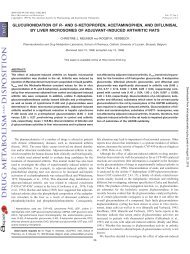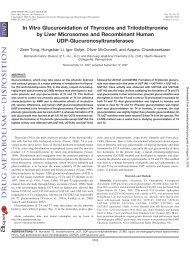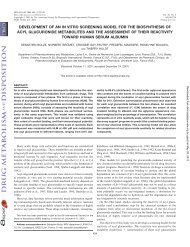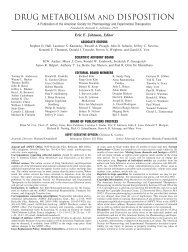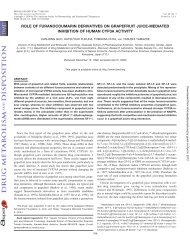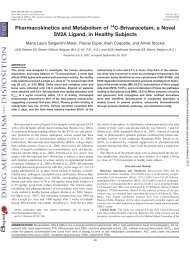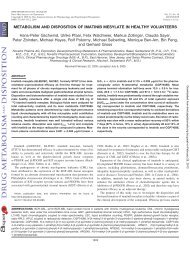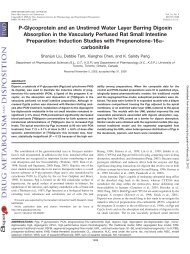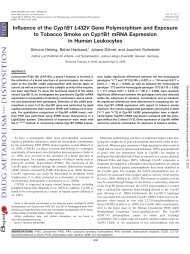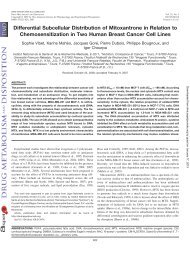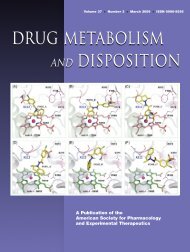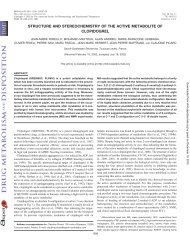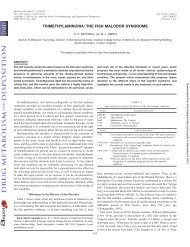pharmacokinetics and plasma protein binding of tamsulosin - Drug ...
pharmacokinetics and plasma protein binding of tamsulosin - Drug ...
pharmacokinetics and plasma protein binding of tamsulosin - Drug ...
You also want an ePaper? Increase the reach of your titles
YUMPU automatically turns print PDFs into web optimized ePapers that Google loves.
TABLE 2<br />
Pharmacokinetic parameters <strong>of</strong> <strong>tamsulosin</strong> after oral administration to rats<br />
Parameter<br />
Dose (mg/kg)<br />
1 3 10<br />
C max (ng/ml) 6.5 56.1 283.9<br />
T max (hr) 0.125 0.125 0.125<br />
AUC 0– (nghr/ml) 8.8 a 55 290<br />
t 1/2 (hr) — b 0.99 1.15<br />
CL oral (l/hr/kg) 113.6 c 54.5 34.5<br />
F (%) 6.9 c 14.4 22.8<br />
Values represent the mean <strong>of</strong> three (1 <strong>and</strong> 3 mg/kg) or four (10 mg/kg) rats.<br />
a<br />
0–4 hr value (AUC0–4 h).<br />
b<br />
Not calculable due to insufficient data points.<br />
c<br />
Calculated using the AUC0–4 hr.<br />
TABLE 3<br />
Pharmacokinetic parameters <strong>of</strong> <strong>tamsulosin</strong> after oral administration to dogs<br />
Parameter<br />
Dose (mg/kg)<br />
0.3 1 3<br />
C max (ng/ml) 37 3 146 36 433 50<br />
T max (h) 0.13 0.00 0.34 0.10 0.50 0.10<br />
AUC 0– (nghr/ml) 78 9 259 22 1100 171<br />
t 1/2 (h) 1.44 0.11 1.68 0.10 1.27 0.05<br />
CL oral (l/hr/kg) 3.99 0.44 3.94 0.32 3.01 0.48<br />
F (%) 29.8 3.3 29.7 2.5 42.0 6.5<br />
Values represent the mean SEM <strong>of</strong> four (0.3 <strong>and</strong> 1 mg/kg) or five (3 mg/kg) dogs.<br />
FIG. 5.Plasma concentration-time pr<strong>of</strong>iles <strong>of</strong> unchanged <strong>tamsulosin</strong> in human<br />
male volunteers. Each point represents the mean SD <strong>of</strong> four volunteers. (■)<br />
0.05 mg; (F) 0.1 mg; (Œ) 0.2 mg.<br />
dosing in the present study was 1.3 l/hr/kg in rats <strong>and</strong> 0.11 l/hr/kg in<br />
dogs, suggesting a small contribution to CL tot (16% <strong>and</strong> 9%, respectively).<br />
These findings indicate that the elimination <strong>of</strong> <strong>tamsulosin</strong> in<br />
rats <strong>and</strong> dogs is attributable to nonrenal elimination, such as hepatic<br />
metabolism. CL B values in rats <strong>and</strong> dogs calculated as CL tot/R B were<br />
6.57 l/hr/kg <strong>and</strong> 1.61 l/hr/kg, respectively, being larger than hepatic<br />
blood flow rate (Qh) in rats, <strong>and</strong> smaller than Qh in dogs (Qh: 3.5<br />
l/hr/kg <strong>and</strong> 2.6 l/hr/kg, respectively) (Dedrick et al., 1973; Greenway<br />
<strong>and</strong> Stark, 1971). These data indicate that the clearance <strong>of</strong> <strong>tamsulosin</strong><br />
is “hepatic blood flow-limited” in rats <strong>and</strong> “intermediate flow-dependent”<br />
in dogs. Although data for intravenous dosing to humans were<br />
not obtained in the present clinical study, CL tot value in a previous<br />
study in humans was 0.037 l/hr/kg (2.88 l/hr) (Hoogdalem et al.,<br />
PHARMACOKINETICS OF TAMSULOSIN<br />
TABLE 4<br />
Pharmacokinetic parameters <strong>of</strong> <strong>tamsulosin</strong> after oral administration to humans<br />
Parameter<br />
Dose (mg)<br />
0.05 0.1 0.2<br />
C max (ng/ml) 3.3 0.7 7.2 1.8 12.8 2.2<br />
T max (h) 1.0 0.0 1.8 0.5 1.6 0.6<br />
AUC 0– (nghr/ml) 27.5 4.2 57.0 7.7 85.5 15.8<br />
t 1/2 (h) 6.33 0.54 6.79 1.05 5.25 0.93<br />
CL oral (l/hr) 1.95 0.31 1.85 0.23 2.61 0.49<br />
(l/hr/kg) 0.033 0.005 0.031 0.003 0.041 0.009<br />
Values represent the mean SEM <strong>of</strong> four volunteers.<br />
TABLE 5<br />
Plasma <strong>protein</strong> <strong>binding</strong> <strong>and</strong> RB value <strong>of</strong> <strong>tamsulosin</strong> in rats, dogs, <strong>and</strong> humans<br />
<strong>Drug</strong> concentrations a<br />
(ng/ml)<br />
Rats Dogs Humans<br />
% bound (fu) 200 80.6 (0.194) 90.2 (0.098) 98.9 (0.011)<br />
600 79 (0.210) 90.3 (0.097) 99.1 (0.009)<br />
R B 50 1.20 0.72 ND<br />
200 ND ND 0.53<br />
Values represent the mean <strong>of</strong> triplicate determinations.<br />
ND, Not determined.<br />
a Nominal concentration <strong>of</strong> 14 C-<strong>tamsulosin</strong> in <strong>plasma</strong> or blood before centrifugation.<br />
TABLE 6<br />
Estimated pharmacokinetic parameters based on the <strong>plasma</strong> unbound <strong>tamsulosin</strong><br />
in rats, dogs, <strong>and</strong> humans<br />
Estimated parameter Rats Dogs Humans<br />
CL oral/fu (l/hr/kg) 164–586 31–41 2.8–4.6<br />
V dss/fu (l/kg) 13.6–14.7 17.6–17.9 18.6–22.8 a<br />
243<br />
CL oral/fu: unbound oral clearance; V dss/fu, distribution volume based on unbound <strong>tamsulosin</strong>.<br />
Estimations use fu values determined using 14 C-<strong>tamsulosin</strong> at the <strong>plasma</strong> concentration <strong>of</strong><br />
200 <strong>and</strong> 600 ng/ml.<br />
a Mean value for Vdss in humans is 0.205 l/kg (Hoogdalem et al., 1997).<br />
1997). This value was much smaller than Qh in humans (94 l/hr)<br />
(Greenway <strong>and</strong> Stark, 1971), indicating that the clearance <strong>of</strong> <strong>tamsulosin</strong><br />
is “flow-independent.”<br />
Interspecies variation in the <strong>pharmacokinetics</strong> <strong>of</strong> <strong>tamsulosin</strong> was<br />
observed among rats, dogs, <strong>and</strong> humans after oral dosing. Plasma<br />
concentrations in dogs <strong>and</strong> humans increased proportionally with an<br />
increase in dose, whereas those in rats increased nonlinearly over the<br />
dose range studied. In addition, CL oral values in rats <strong>and</strong> dogs were<br />
about 100 times <strong>and</strong> 1000–3000 times higher than that in humans,<br />
respectively, thus showing a large interspecies difference. Probable<br />
causes <strong>of</strong> the interspecies differences in CL oral include differences in<br />
the amount <strong>of</strong> absorption, systemic clearance, or presystemic extraction<br />
in the liver. The amount <strong>of</strong> radioactivity absorbed in rats <strong>and</strong> dogs<br />
after oral dosing <strong>of</strong> 14 C-<strong>tamsulosin</strong> at a dose <strong>of</strong> 1 mg/kg under fasting<br />
conditions was more than 99% <strong>and</strong> ca. 90% over 72 hr, respectively<br />
(unpublished data), <strong>and</strong> absolute bioavailability in humans was approximately<br />
100% (Hoogdalem et al., 1997), suggesting that the<br />
interspecies difference is not caused by any difference in absorption.<br />
The absolute bioavailability, however, varied widely among the species<br />
(rats: 6.9–22.8%, dogs: 29.7–42.0%, humans: approx. 100%).<br />
These findings indicate that the interspecies difference in the CL oral <strong>of</strong><br />
<strong>tamsulosin</strong> is a result not only <strong>of</strong> differences in systemic clearance but<br />
also <strong>of</strong> hepatic availability (Fh).<br />
CL oral, CL tot, <strong>and</strong> Fh are hybrid parameters defined by individually<br />
independent parameters, such as organ blood flow, intrinsic clearance,<br />
fu, <strong>and</strong> R B. The CL oral <strong>of</strong> hepatically cleared drugs which are well<br />
absorbed but not metabolized in the gut wall or by microorganisms in<br />
the alimentary tract is generally expressed as the product <strong>of</strong> fu <strong>and</strong><br />
Downloaded from<br />
dmd.aspetjournals.org by guest on May 28, 2013



